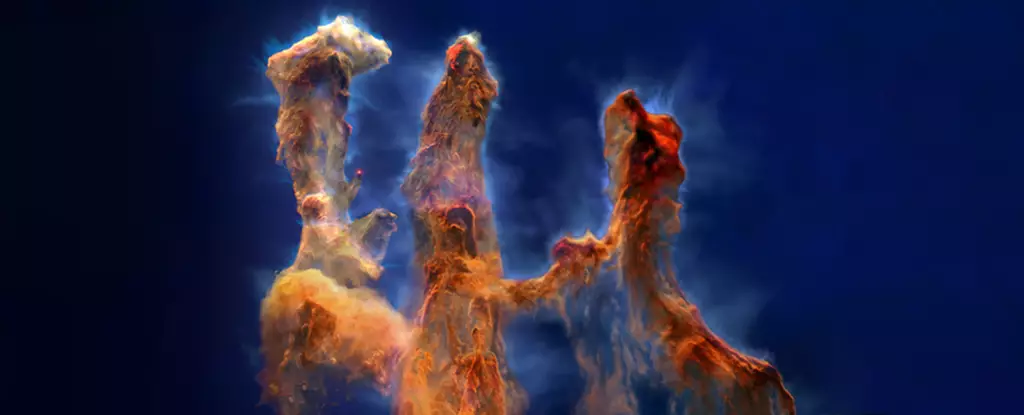The month of April 1995 marked a significant event in the world of astronomy with the release of the iconic image known as the “Pillars of Creation.” This stunning image, captured by the Hubble Space Telescope, showcased the beauty and complexity of the Eagle Nebula. Now, the James Webb Telescope has joined in on the action by snapping new images of the nebula. Recently, astronomers have combined data from both Hubble and Webb to create a captivating 3D animation that takes viewers on a virtual flight through the nebula.
The Pillars of Creation are primarily composed of cool molecular hydrogen and dust, being gradually eroded by strong winds and ultraviolet radiation from nearby hot, young stars. These towering structures, resembling colossal cosmic fingers, have additional protrusions extending from their tops, larger than the solar system itself. Embedded within these pillars are young, hot stars, with the tallest pillar measuring an impressive three light-years from top to bottom.
The newly released 3D movie provides viewers with a unique opportunity to explore the intricate structures of the Pillars of Creation, based on real observational data from a study led by Anna McLeod, an associate professor at the University of Durham. This visualization not only offers a breathtaking view of the nebula but also highlights the collaborative efforts of two of the world’s most powerful space telescopes – Hubble and Webb.
The 3D movie allows viewers to delve into various aspects and stages of star formation within the Eagle Nebula. For instance, the central pillar features an infant protostar glowing bright red in the infrared image. Additionally, a diagonal jet of material ejected from a newborn star can be observed near the top of the left pillar, revealing the presence of a hot young star. At the tip of one protrusion on the left pillar shines a new star, adding to the beauty and complexity of the nebula.
Aside from offering a visually stunning experience, the 3D visualization of the Pillars of Creation has paved the way for the creation of a 3D printable model. By converting the data into an STL file format, individuals can now download and print their own models at home using 3D printers. This not only appeals to astronomy enthusiasts but also holds immense educational value for schools, providing a hands-on learning experience for students interested in the wonders of the cosmos.
The collaboration between the Hubble and Webb telescopes, coupled with the advancements in 3D visualization technology, has brought forth a unique and immersive experience for viewers to explore the beauty and complexity of the Pillars of Creation in the Eagle Nebula. As we continue to unravel the mysteries of the universe, such innovative approaches help us appreciate the awe-inspiring wonders that exist beyond our world.


Leave a Reply